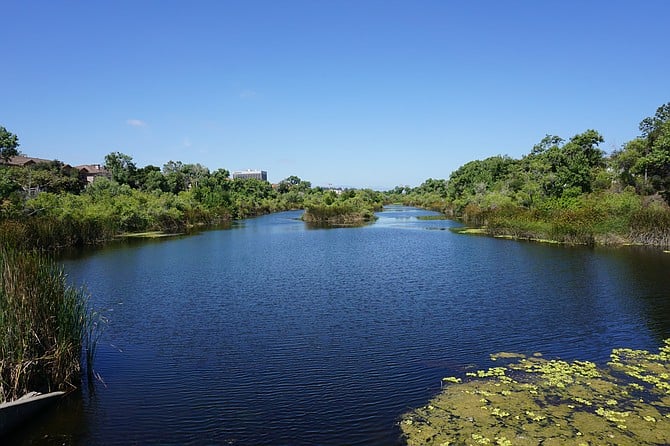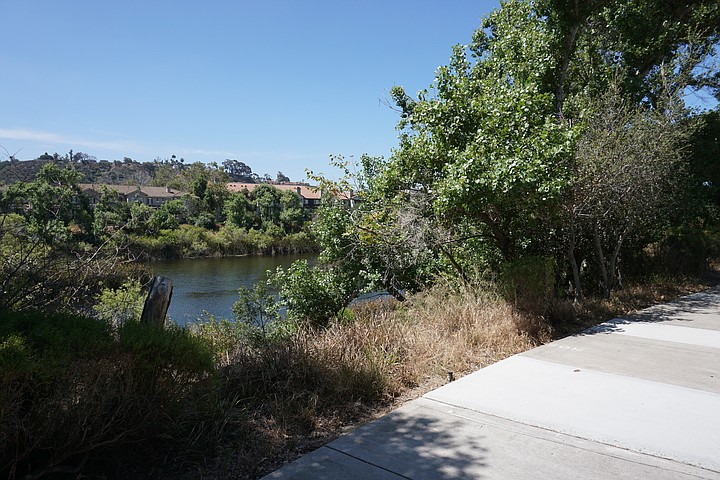 Facebook
Facebook
 X
X
 Instagram
Instagram
 TikTok
TikTok
 Youtube
Youtube

The County of San Diego Department of Parks and Recreation is working to construct a seamless network of trails that will follow the route of the San Diego River from the mountains down to the coast. The project is still in the planning stages and has been in progress for decades now. It seems to have new momentum after the county board of supervisors recently prioritized it. The project is being referred to as the San Diego River Park Trail.
Lizzy Bendrick, the trails program manager for the county, spoke about the project during a recent public meeting.
“The vision is to establish a trail system from the mountains to the ocean,” she said. “So, potentially, the town of Julian down to the mouth of the Pacific Ocean at Ocean Beach. This connected system will serve as a unifying thread.... The main trail is called the San Diego River Trail, which is a multi-purpose path for pedestrians, cyclists and equestrians in some areas.”

If a seamless trail system in San Diego connecting the mountains to the coast rings a bell, you may be thinking of the Coast to Crest Trail. It’s a similar project that begins near Julian, but which heads north and west in the mountains through Santa Ysabel and Pamo Valley, before descending towards Lake Hodges and eventually reaching the ocean in Del Mar. The San Diego River trail appears to be following the same Coast to Crest model of using established trails with the hopes of building new ones to fill in the blanks. The Coast to Crest Trail has been in the works for decades, and still has large, unconnected swaths of land near Lake Sutherland and the San Dieguito River along with other shorter stretches that need to be connected.
Judging by a map shown during the meeting, the portion of the route which spans from Ocean Beach to Lakeside is composed of completed trail and sidewalk segments along with some planned trail segments to fill in the gaps. As the trail heads northeast from Lakeside towards Julian the route seems less defined — proposed trail segments are shown with a large chunk of the Trans-County Trail (a 155-mile trail system that runs from the eastern boundary of San Diego County near the Salton Sea to Torrey Pines State Natural Reserve) connecting segments together. Portions of the system will include trails on both sides of the river, so the overall mileage length of the entire trail system will surpass the actual 52-mile corridor of the river that they are designed to follow.
Mark Buckley, a representative from ECONorthwest — a company working with the county to develop funding options for the trail system, mentioned that once you get upstream of the El Capitan Reservoir, in what he referred to as the “upper headwaters section of the trail” the route was not yet planned, and the intention was to avoid tribal lands in that region. “So, the route is going to take a wider path away from the river and it’s not clear what that path will be right now,” he said. “We’re talking to the Forest Service; the longer and the lower grade the trails the more expensive they can be. The more direct and potentially steeper, the less expensive it can be to develop those kinds of trails depending on what you have to cut through — granite and things like that.” In essence, depending on how much funding the project receives, this may become the section of the trail system that will be more of a challenge than much of what you would find in regions such as Mission Valley and Santee.
And speaking of funding, that is exactly what the county is trying to figure out right now — where is the money for this project going to come from? “In March 2021, the county board of supervisors chair Nathan Fletcher assembled a task force related to the San Diego River Park,” Bendrick explained. “One of the issues identified by the task force was that there is no set funding source to acquire land, implement trails, and complete other projects along the river and for on-going operations and maintenance. One of the outcomes of the task force was that a long-term funding mechanism was needed to turn this long-term vision into a reality.”
During the meeting, options in this realm included state and federal grants, fees and charges associated with private development, infrastructure tax districts and local community, voter-approved taxes and fees. A funding report will be presented to the county board of supervisors this summer and it could be a critical step in making this patchwork trail system a reality. Judging by the Coast to Crest Trail though, don’t expect all the pieces of the puzzle to fall in place in the next couple of years.


The County of San Diego Department of Parks and Recreation is working to construct a seamless network of trails that will follow the route of the San Diego River from the mountains down to the coast. The project is still in the planning stages and has been in progress for decades now. It seems to have new momentum after the county board of supervisors recently prioritized it. The project is being referred to as the San Diego River Park Trail.
Lizzy Bendrick, the trails program manager for the county, spoke about the project during a recent public meeting.
“The vision is to establish a trail system from the mountains to the ocean,” she said. “So, potentially, the town of Julian down to the mouth of the Pacific Ocean at Ocean Beach. This connected system will serve as a unifying thread.... The main trail is called the San Diego River Trail, which is a multi-purpose path for pedestrians, cyclists and equestrians in some areas.”

If a seamless trail system in San Diego connecting the mountains to the coast rings a bell, you may be thinking of the Coast to Crest Trail. It’s a similar project that begins near Julian, but which heads north and west in the mountains through Santa Ysabel and Pamo Valley, before descending towards Lake Hodges and eventually reaching the ocean in Del Mar. The San Diego River trail appears to be following the same Coast to Crest model of using established trails with the hopes of building new ones to fill in the blanks. The Coast to Crest Trail has been in the works for decades, and still has large, unconnected swaths of land near Lake Sutherland and the San Dieguito River along with other shorter stretches that need to be connected.
Judging by a map shown during the meeting, the portion of the route which spans from Ocean Beach to Lakeside is composed of completed trail and sidewalk segments along with some planned trail segments to fill in the gaps. As the trail heads northeast from Lakeside towards Julian the route seems less defined — proposed trail segments are shown with a large chunk of the Trans-County Trail (a 155-mile trail system that runs from the eastern boundary of San Diego County near the Salton Sea to Torrey Pines State Natural Reserve) connecting segments together. Portions of the system will include trails on both sides of the river, so the overall mileage length of the entire trail system will surpass the actual 52-mile corridor of the river that they are designed to follow.
Mark Buckley, a representative from ECONorthwest — a company working with the county to develop funding options for the trail system, mentioned that once you get upstream of the El Capitan Reservoir, in what he referred to as the “upper headwaters section of the trail” the route was not yet planned, and the intention was to avoid tribal lands in that region. “So, the route is going to take a wider path away from the river and it’s not clear what that path will be right now,” he said. “We’re talking to the Forest Service; the longer and the lower grade the trails the more expensive they can be. The more direct and potentially steeper, the less expensive it can be to develop those kinds of trails depending on what you have to cut through — granite and things like that.” In essence, depending on how much funding the project receives, this may become the section of the trail system that will be more of a challenge than much of what you would find in regions such as Mission Valley and Santee.
And speaking of funding, that is exactly what the county is trying to figure out right now — where is the money for this project going to come from? “In March 2021, the county board of supervisors chair Nathan Fletcher assembled a task force related to the San Diego River Park,” Bendrick explained. “One of the issues identified by the task force was that there is no set funding source to acquire land, implement trails, and complete other projects along the river and for on-going operations and maintenance. One of the outcomes of the task force was that a long-term funding mechanism was needed to turn this long-term vision into a reality.”
During the meeting, options in this realm included state and federal grants, fees and charges associated with private development, infrastructure tax districts and local community, voter-approved taxes and fees. A funding report will be presented to the county board of supervisors this summer and it could be a critical step in making this patchwork trail system a reality. Judging by the Coast to Crest Trail though, don’t expect all the pieces of the puzzle to fall in place in the next couple of years.
Comments